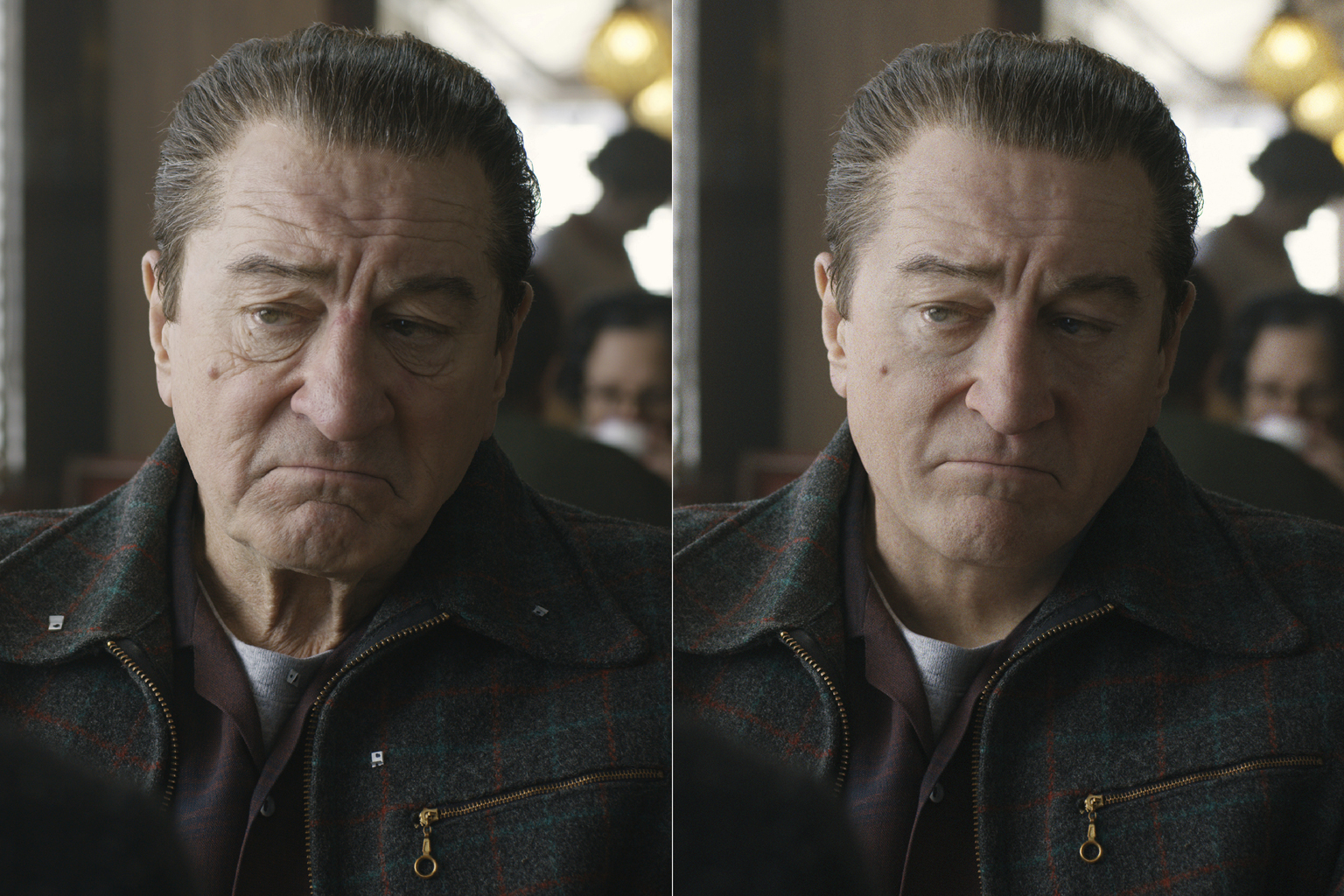Digital effects turn back the clock for ageing actors
Sign up now: Get ST's newsletters delivered to your inbox

Actor Robert De Niro’s original (left) and de-aged faces. The effect was achieved with the use of a unique “three-headed” camera rig.
PHOTO: NETFLIX
Follow topic:
LONDON • With director Martin Scorsese's The Irishman expected to battle Once Upon A Time In... Hollywood and 1917 for the best picture Oscar next month, all eyes are on the special effects team that made the sprawling crime epic possible.
The Irishman unfolds over decades, with 76-year-old actor Robert De Niro and his co-stars playing their characters from their 30s into retirement age, a feat that has made the film one of last year's most acclaimed movies.
It is all possible through new digital de-ageing techniques that, in the past year in cinemas, have shaved decades from actor Samuel L. Jackson's face and turned back the clock to the 1990s for actor Will Smith.
Each film arrived at its reverse ageing trick through a different technique, leading some to call last year a monumental year for deageing in film.
To many, The Irishman stands out from the rest of the field, thanks to its complete avoidance of "tracking markers" - dots painted on actors' faces which allow computers to mathematically replicate facial movements and manipulate them as the director sees fit.
The youthful transitions of The Irishman are the work of Mr Pablo Helman, visual effects supervisor at Industrial Light & Magic (ILM), who says the decision to forgo tracking markers came directly from Scorsese and De Niro.
"He's not going to wear a helmet with little cameras in there," says Mr Helman. "He's going to want to be in the moment with Joe Pesci and Al Pacino on set, with no markers on him."
Enter the "three-headed monster," a unique camera rig that has a "director" camera in the centre and two "witness" cameras on either side shooting infrared footage. That allowed Mr Helman to eliminate shadows created by on-set lighting, which could potentially interfere with the geometric facial shapes constructed by de-ageing software.
While the team at ILM was working on The Irishman, another group of technical wizards was experimenting with de-ageing at director Peter Jackson's Weta Workshop in New Zealand, creating an entirely digital, 23-year-old version of Smith for the action movie Gemini Man.
"Since I started visual FX 25 years ago, it's been the holy grail," says Mr Bill Westenhofer, one of the film's VFX supervisors. "You have that many years of expertise of looking at a human face and knowing what's wrong. So, to try and get all the different things together and get it to pull off right - that's been the challenge."
To create the character of Junior - a younger clone of Smith's assassin Henry Brogan - the superstar wore the traditional grey tracksuit, complemented by a head rig with two cameras capturing his facial expressions via tracking markers.
"We decided (on) a ground-up approach to build everything from scratch - from the skull all the way to the skin pores, all the way to the animation and the final kind of oil in the eyes was really the best approach we could take," says Mr Stu Adcock, head of facial motion at Weta.
Before filming commenced on both Gemini Man and The Irishman, the teams at ILM and Weta drew up test footage to show the films' directors that what they were suggesting was possible.
For Gemini Man, it was a clip from the 1995 movie, Bad Boys, into which they inserted two shots of their new, digital Smith and asked director Lee Ang to spot the "fake".
For The Irishman, De Niro also returned to the 1990s, performing the Pink Cadillac scene from Goodfellas (1990) before being de-aged in post-production - convincing an initially sceptical Scorsese that he could bring the long-gestating project to life.
Creating Junior required Smith to spend time in a photogrammetry booth, where multiple cameras captured his likeness as numerous lights fired in different sequences, giving a base scan of the actor and analysing the structure of his face from the skin pore level.
Ironically, considering Scorsese's vocal criticism of Marvel movies as "not cinema", a similar system was used to de-age Jackson in Captain Marvel. A young Nick Fury was created by comparing footage from old Jackson movies with the work the actor did on set - again, using tracking markers.
"I looked at that face as, you know, maybe The Negotiator face," says Jackson, referring to his 1998 movie of the same name. "Fortunately for them and me, I had enough stuff from that period in my life they could use... to put that face together that made sense to people who knew me from that time."
ASSOCIATED PRESS

